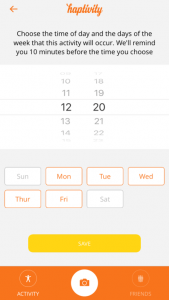Positive emotions and exercise: Developing an app to increase physical activity
By rmjdlro, on 28 February 2017
Mobile phone apps are commonplace in today’s society and for millions of people they are a part of everyday life. In 2016 alone, worldwide downloads exceeded 90 billion1. Apps tracking calorie consumption, exercise, steps, food points and so on, have become increasing popular. Physical activity apps in particular, have been shown to be effective in increasing people’s levels of physical activity2-3. However, most physical activity apps are tailored towards those who enjoy recording information about their performance and/or enjoy the competitive element offered by most fitness apps. Currently there are no physical activity apps which focus on the pleasure that someone might experience from doing the activity itself.
In our new study, published this week, we aimed to develop a physical activity app that would allow users to record positive images and feelings about the activity they performed, whether that was walking the dog or going to the gym, as well as encouraging them to make it a habit. We reasoned that linking positive feelings to a particular activity would increase the likelihood that the user would perform the activity more frequently, which would make it more likely to become a habit.
The app (‘Haptivity’) allowed users to take a photo every time they carried out an activity, to remind them of any positive feelings they had. Then, at a specific time each day the user would receive a reminder to be active, coupled with a photo that the user had previously uploaded. Each time users were active they would be prompted to take another photo. Users were able to look at these photos any time they liked and could receive positive feedback from other app users who they had connected with.
The app was developed along with a group of participants who helped to design and test it. Participants were aged 35-55 and said that they didn’t do any exercise at the moment, but would like to be more active. Participants initially attended a meeting to discuss what they wanted and needed in apps in general and in physical activity apps specifically. A few months later participants attended a second meeting where they were asked to download the app and to discuss their initial thoughts. At this point they were asked to complete a questionnaire about how much physical activity they were currently doing and other psychological factors related to physical activity. Participants then went away and tested the app in their own time before returning for a final meeting where their experience of using the app was discussed and they were asked to complete the same questionnaire again. This was to assess whether there had been any change in their physical activity levels whilst they were using the app, although it is important to point out that the aim of the study was to develop the app, not to increase physical activity levels at this point.
The feedback provided by participants was generally positive and suggested that it motivated them to be more active, although they had suggestions as to how to improve the app, such as being able to quantify the activities performed (e.g. recording time spent doing an activity) and being able to make the photos more interesting using photo editing, for example. Small improvements were seen in the amount of time people spent walking, although there were also reductions in the amount of time spent performing activities at a moderate and vigorous level of exertion. Overall, participants thought that the app was acceptable although it will need to be developed and tested further, with a larger number of participants, to incorporate their suggested changes.
1 App Annie 2016 Retrospective – Mobile’s Continued Momentum. https://www.appannie.com/insights/market-data/app-annie-2016-retrospective/
2 Foster, C., J. Richards, et al. (2013). Remote and web 2.0 interventions for promoting physical activity. Cochrane Database of Systematic Reviews, 9, CD010395.
3 Richards, J., M. Hillsdon, et al. (2013). Face-to-face interventions for promoting physical activity. Cochrane Database of Systematic Reviews, 9, CD010392.
 Close
Close




